Francesco Deiana is an Italian artist, living and working in San Francisco for many years. His new work at Aimee Friberg’s CULT gallery is all about contradictions. Deiana designs large scale shapes relating to historical works ranging from Franz Kline’s gestural works to the geometries of Stella and Tuttle. Carefully covering them with graphite marks, he creates trompe-l’œil imagery of interference patterns, which he transfers from his computer screen. Recently I had the opportunity to speak to him about his work.
MG: Your graphite drawings are intriguing. Please talk about the idea behind your process:
FD: I find really interesting the process of translation between the digital and analog images, which was always part of my work. I like the idea of confusing the eye, not knowing if my work was done by hand or by computer. I took this idea to the limit in this show basically as I combined computer images with graphite drawings.
MG: The Haptic Series is the main part of your current show, can you describe how you make it:
FD: For these works I design most of the outlines in my sketchbook first. Then I reproduce them in large scale, outlining the shapes and filling in the black areas on a table. Step two is to hang the piece on a wall to give me the possibility to step back for proportions. I draw the wave patterns in it, copying it from the distortion created on my photographs shot through my computer screen. Step three is to put back the piece on a table and cross the whole thing with lines done with ruler and pencil to give you the idea of something machine made (computer or copy machine) and also to give a heavy texture to the drawing. The entire work is done with graphite. I love the fact that you can see my hand-work in them. Looking at these waves, your imagination can go through it. As a viewer, you wonder right away how is it done. You can also imagine these waves looking like fabric surfaces or sonar waves.
MG: Another impressive work is your large Photoshop Brushstroke, 2015. Could you describe the process here:
FD: I started here by drawing a shape with my finger in one continuous movement using Photoshop. It’s a gesture digitally done and reproduced by hand with a body move instead using a finger because the scale of it; but it’s a gesture in the same way. The entire piece is filled up using pencils/ graphite sticks. The graphite looked layered on the gesso surface, showing the overlap of the shapes in the big work. It was the idea of gestural work in Photoshop that was interesting to me, and reproducing it on a large scale was such a time consuming work with an intense result.
MG: You also exhibit a site-specific sculptural installation, could you talk about it:
FD: My sculpture began with a projected shape on a found object, which I painted and coated with graphite. The piece is closed in a room and you can only look at it from the entrance. That way it will limit the points of view you can see it from and give more space to your imagination. I painted the room and sculpture all gray as it is in the computer programs for 3D renders. I wanted it to be read as a three dimensional sketch of my two dimensional work for a potential sculpture; to be then reproduced in steel and in a bigger scale.
MG: How do you decide on the overall shapes of your drawings and who has influenced your work:
FD: My shapes are an evolution of my designs. Every shape is different, sometimes they are related to architecture. As I said I see many of my drawings as the models for potential sculptures. I envision them as huge metal cuts. The influence from architecture has to do with the fact that I am Italian and where I grew up. I think my work is really strong, almost invasive for your eyes in a way. It’s aggressive and kind of extreme but there are also soft and delicate parts in it. It almost feels like a contradiction. For example, the wave- shapes looks almost like fabric while, on the other hand, the shape that encloses them is solid and heavy. I started to make this series of works last year after I visited Rome where I helped a friend with his show. We were surrounded with good art and artists from the 1960s to the 1980’s . I had access to a lot of inspiring art and people. Artists like Mario Schifano, Lucio Fontana, Sol Lewitt, Joan Jones, Pat Steir… Their work was really inspiring.
MG: You process seems to be about the risk. You are taking the work physically to the edge where it can be ruined just by any small error you make.
FD: It is true, my process reflects a lot of who I am. At the beginning of my career when I was doing a lot of shading with ballpoint pens, my rule was not to make any visible mistakes for my eyes at a distance of like one inch from the paper. This way the work would almost look dimensional/ mechanical from faraway, almost computer made. Still, even as my work can look very precise it’s full of imperfections, miscalculations and sometimes very off results. In reality I don’t calculate much, I just draw all my shapes, overlapping my rulers for sizes and using a cord and nails to do the circle parts. I am trying to get better at calculating what is happening with my pieces but they are pretty freely made.
Interview by Michal Gavish
“Haptic Render”
Solo Exhibition: Francesco Igory Deiana
CULT: Aimee Friberg Exhibitions
3191 Mission Street San Francisco 94110
info@cultexhibitions.com
415-800-6604
Gallery hours: Wednesday – Saturday 12 – 6pm
Filed under: Aimee Friberg, CULT Exhibitions, Francesco Igory Deiana, Michal Gavish, San Francisco Galleries | Leave a comment »



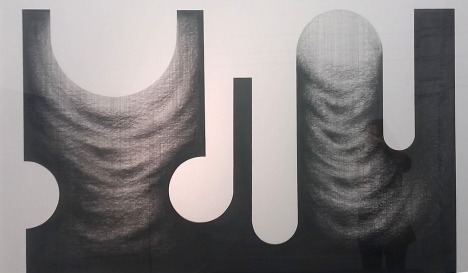
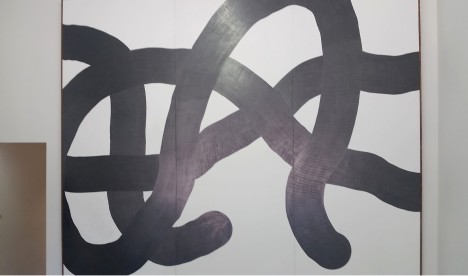
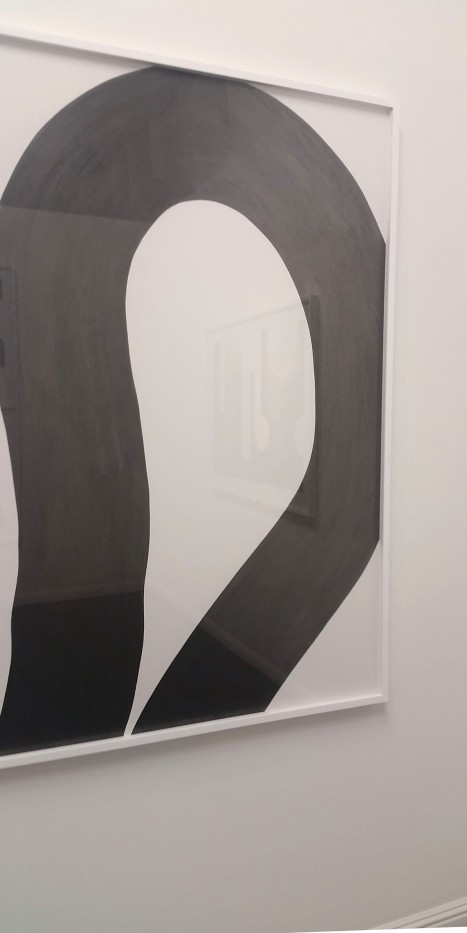
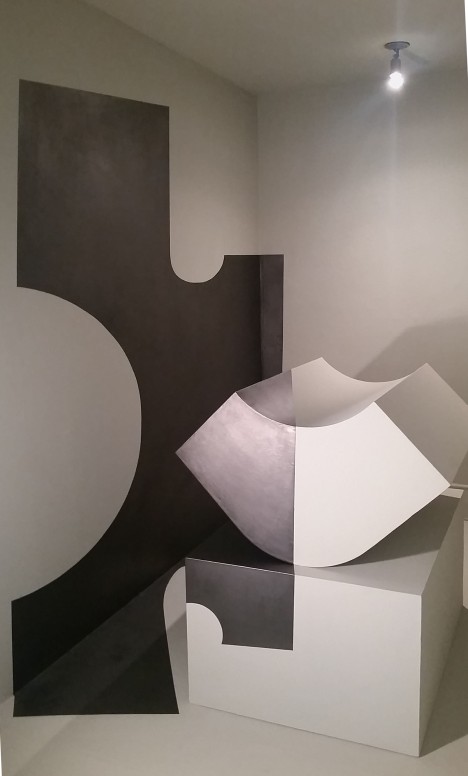
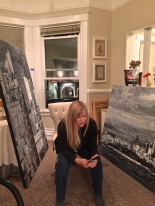
 “both”. She paints what she loves. However, the process of laying down thick impasto is not simply playing with color relationships nor is it simply studies in light and shadow. It is those things, but more importantly it is classically expressionistic. Within the framework of constrained subject matter, she uses the paint as a way of directly and subconsciously exploring her feelings about the subject.
“both”. She paints what she loves. However, the process of laying down thick impasto is not simply playing with color relationships nor is it simply studies in light and shadow. It is those things, but more importantly it is classically expressionistic. Within the framework of constrained subject matter, she uses the paint as a way of directly and subconsciously exploring her feelings about the subject.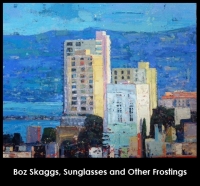
 among others, pulled back from that purism. They incorporated the emotional power of the medium itself into their paintings; but, they also used specific subjects as a scaffolding within which to explore those emotions. The subject matter was not a crutch. Both medium and subject shared equal billing. This is the legacy that Carolyn Meyer continues to explore. And, like those artists, what makes her work powerful is the very personal nature of that exploration.
among others, pulled back from that purism. They incorporated the emotional power of the medium itself into their paintings; but, they also used specific subjects as a scaffolding within which to explore those emotions. The subject matter was not a crutch. Both medium and subject shared equal billing. This is the legacy that Carolyn Meyer continues to explore. And, like those artists, what makes her work powerful is the very personal nature of that exploration. Close but no cigar. She likes having the physical references to these “almost successes”in her studio, almost like documentation of the different paths. There is a voice that wants to heard. And, it is the search for perfect pitch that keeps her painting.
Close but no cigar. She likes having the physical references to these “almost successes”in her studio, almost like documentation of the different paths. There is a voice that wants to heard. And, it is the search for perfect pitch that keeps her painting.
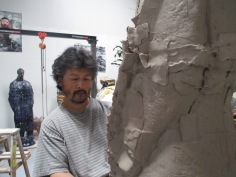
 essentially non-existent just before he started his studies. Then, the rigid control began to crack. Catalogs from contemporary Western exhibitions began to circulate at Lu Xun. The light of possibilities began to brighten. In 1985, Robert Rauschenberg had an exhibit in China. Abstract expressionism had arrived. And, around the same time, Wanxin made a field trip with his school to the burial tomb of China’s first emperor Qin Shi Huang which had opened at Xiàn where 7500 terra cotta warriors and horses had been unearthed from four excavation pits. He made endless drawings. Two of the three key elements of vocabulary that would inform Wanxin’s art over the next 30 years were now in place. The terra cotta warriors provided the ostensible subject matter of his signature series of work: Pit # 5; and, abstract expressionism gave him the freedom to use the subject improvisationally to explore a broad range of cross-cultural observations.
essentially non-existent just before he started his studies. Then, the rigid control began to crack. Catalogs from contemporary Western exhibitions began to circulate at Lu Xun. The light of possibilities began to brighten. In 1985, Robert Rauschenberg had an exhibit in China. Abstract expressionism had arrived. And, around the same time, Wanxin made a field trip with his school to the burial tomb of China’s first emperor Qin Shi Huang which had opened at Xiàn where 7500 terra cotta warriors and horses had been unearthed from four excavation pits. He made endless drawings. Two of the three key elements of vocabulary that would inform Wanxin’s art over the next 30 years were now in place. The terra cotta warriors provided the ostensible subject matter of his signature series of work: Pit # 5; and, abstract expressionism gave him the freedom to use the subject improvisationally to explore a broad range of cross-cultural observations.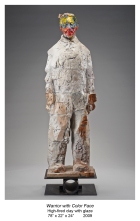
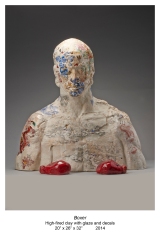
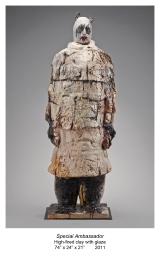 Wanxin noted that his work is about questions, not answers. In his signature series: Pit # 5, the terra cotta warriors are a surrogate for the Chinese subordination of the individual to the needs of society as whole. The addition of humorous, anachronistic elements to his versions of the warriors allows him to comment on society. One might make the assumption that he is criticizing the historical lack of individual freedom in China and lauding the individual freedom here in America. That would be a mistake. He noted in an earlier interview with Richard Whittaker in 2012: “Yes, there is great freedom here. The artist can do anything. The question is what?”. I imagine that there was a twinkle in his eye when he said that. Humor draws you into his work. It is easy access. Then, gradually it becomes disconcerting and it makes you question what you know.
Wanxin noted that his work is about questions, not answers. In his signature series: Pit # 5, the terra cotta warriors are a surrogate for the Chinese subordination of the individual to the needs of society as whole. The addition of humorous, anachronistic elements to his versions of the warriors allows him to comment on society. One might make the assumption that he is criticizing the historical lack of individual freedom in China and lauding the individual freedom here in America. That would be a mistake. He noted in an earlier interview with Richard Whittaker in 2012: “Yes, there is great freedom here. The artist can do anything. The question is what?”. I imagine that there was a twinkle in his eye when he said that. Humor draws you into his work. It is easy access. Then, gradually it becomes disconcerting and it makes you question what you know.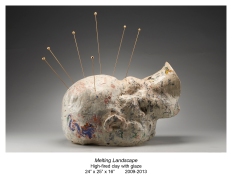

 a reference to a Chinese joke about what goes on under a monk’s robes. Then, there are also decals of traditional Chinese landscape and poetry that have been added to that surface in a third firing. And, the surface treatment of the sculpture itself is compelling on a purely abstract level. The raw, emotional treatment of the clay is undisguised. The work is not just about one thing. It does not have a single point of view. It is serious. It is humorous. It is anti-establishment. It celebrates cultural legacy. It is figurative. It is abstact. It is, for me, the best of what Wanxin has to offer.
a reference to a Chinese joke about what goes on under a monk’s robes. Then, there are also decals of traditional Chinese landscape and poetry that have been added to that surface in a third firing. And, the surface treatment of the sculpture itself is compelling on a purely abstract level. The raw, emotional treatment of the clay is undisguised. The work is not just about one thing. It does not have a single point of view. It is serious. It is humorous. It is anti-establishment. It celebrates cultural legacy. It is figurative. It is abstact. It is, for me, the best of what Wanxin has to offer.
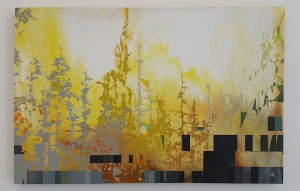
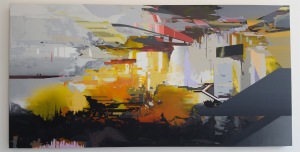
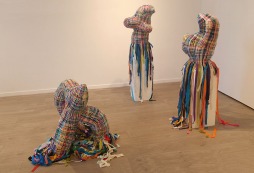

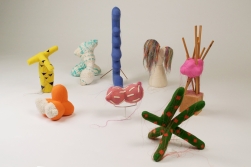
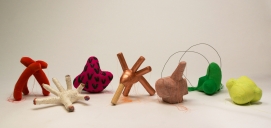 representation to semi-abstraction. Abdicating her familiar and safe practice of embroidering ready-made objects, she now sews her invented figures from scratch. Instead of interpreting she fabricates new figures, shifting her practice to sculpting in cloth.
representation to semi-abstraction. Abdicating her familiar and safe practice of embroidering ready-made objects, she now sews her invented figures from scratch. Instead of interpreting she fabricates new figures, shifting her practice to sculpting in cloth.








